How to connect a gas cylinder to a gas stove: standards and connection guide
Balloon gas allows you to seriously save on cooking in a country house. But you must admit, blue fuel is a source of serious danger. The slightest rush of the connecting pipe or a slight malfunction of the hob, and a fire is inevitable.
In the article we presented, we will describe in detail how to connect a gas cylinder to a gas stove flawlessly and efficiently. We will tell you about the rules, compliance with which will ensure safety at the time of connection and during operation. Our tips will help to avoid errors when connecting propane.
The content of the article:
Is self-service allowed?
Almost all gas workers unanimously argue that connecting a propane cylinder to a gas stove should be done exclusively with their participation, paying them money to call the master. However, this connection is completely allowed to be done with your own hands at no additional cost.
There is nothing fundamentally complicated in this matter. Connecting the gas hob to the cylinder consists in choosing a place for the tank with fuel and organizing from there an outlet in the form of a pipe or flexible hose to the stove.
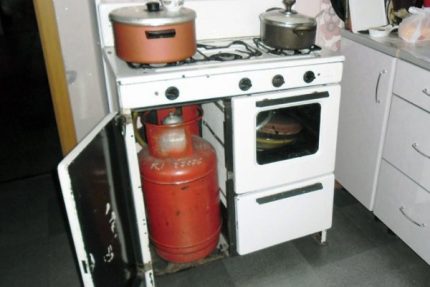
To perform such work requires only basic skills in handling wrenches. Plus, you will have to carefully study and fully comply with the fire safety rules for gas equipment.
A household propane tank is allowed to be installed both inside a residential building and outside. But fire regulations recommend choosing a place to store gas on the street, and not in the kitchen or in the back of the cottage. When outdoors, you will need to install a pipe or hose of a greater length, but then the likelihood of a fire and / or explosion will be less.
Rules for connecting the cylinder to the plate
Requirements for the connection of domestic gas (a mixture of propane and butane) and the corresponding devices are regulated by several documents. The main ones are SP 62.13330.2011 “Gas distribution systems” and “Technical regulation on the safety of home gas equipment”.
Plus there are various fire regulations and building codes. Moreover, in certain issues, these documents are slightly contrary to each other.
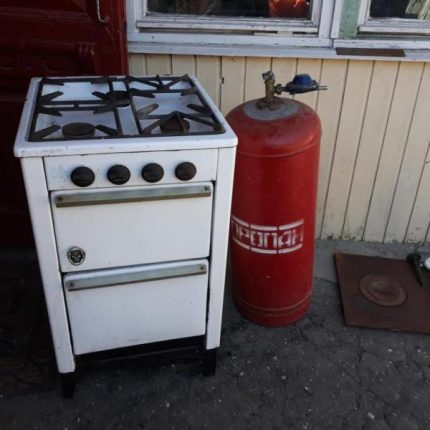
Tank gas has a number of features that directly affect the rules for its use and the norms for connecting equipment. And the main thing here is not methane, as in a pipe, but a propane-butane mixture (LPG) is pumped into the cylinder. Although usually only “propane” is written on the tank.
LPG is obviously heavier than air. When a burner leaks or attenuates, the balloon gas mixture does not rise and does not escape, but descends to the ground.
therefore gas cylinders and it is recommended to be placed on the street so that in an emergency the gas could not accumulate in the underground or basement to a dangerous concentration. They should also be placed as far as possible from wells and any electrical appliances.
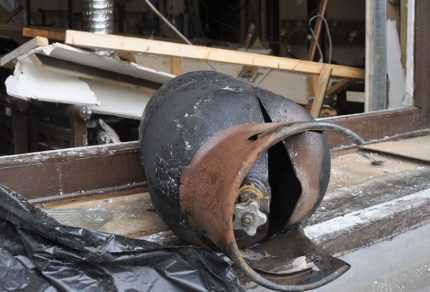
It is legally allowed to place cylinders inside in summer cottages and on summer verandas, as well as in attached kitchens and dining rooms in cottages. It is forbidden only to choose a place for them in living rooms, at emergency exits, in closed dark corridors and basement or basements.
Another important feature of LPG is the existence of “summer” and “winter” fuel. The first differs from the second in the ratio of propane and butane, as well as the ability to "work" at low temperatures.
The summer mixture can be used in winter with not severe frosts. However, when the metal tank is cooled below zero, only propane will be evaporated from it for burning in the stove. But butane will remain inside in liquid form, taking up wasted space and gradually accumulate.
At the same time, refueling the cylinder, they will refill the LPG only partially. So negligent refuellers often deceive inexperienced owners of gas stoves. Plus, at some point, the accumulated liquid condensate will have to be drained from the tank in order to liberate it for working gas.
Necessary tools and materials
To connect a gas bottle to a portable or ordinary room stove, it is usually enough to have only a wrench on hand. It is needed to tighten the nuts on the eyeliner and the gas valve.
But if you plan to put the cylinder tank with LPG on the street with the installation of a special cabinet there, then you will additionally need:
- a drill for punching a wall under a pipe (hose);
- shovel with a sledgehammer for installation and grounding of the cabinet;
- screwdriver;
- roulette.
No specialized tools are required.
A street wardrobe is best chosen by a specialized company. It should be made of steel with a thickness of 1 mm and coated with a special paint, so as not to rust immediately in the first year of operation, as well as have ventilation holes and a key lock.
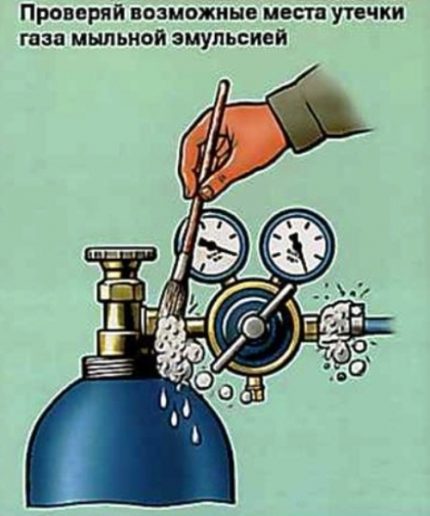
Of the materials you will need:
- Jets for LPG.
- Steel or copper pipe or special gas hose.
- Dielectric insert (if a metal supply is mounted).
- Pressure reducing reducer "frog".
- Sealants.
- Crane.
A stove and gas bottle are also required. Hobs for main methane and LPG are practically no different in design. They only change the jets.
Household cylinders come in volumes of 5, 12, 27 and 50 liters. When fully refueled, they weigh about 6, 11, 26 and 43 kg, respectively. Plus, there are 220 and 400 ml disposable gas cans used as a gas source for portable stoves and blow lamps, they are connected with a small hose or directly to the device.
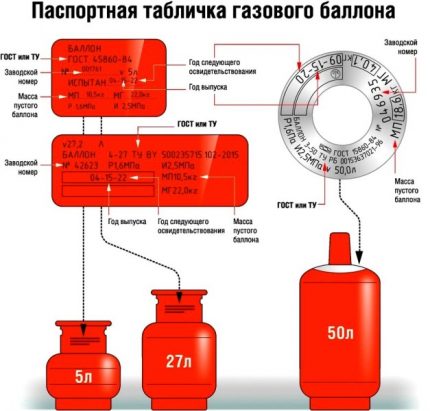
Cylinders are available in the market with valve and valve. It is best to choose a valve option. It allows you to drain the condensate without additional tricks and independently.
Choosing a place for the cylinder
It is permissible to place household cylinders for continuous use with a stove directly next to a gas appliance. There are even tiles with an internal arrangement of the tank for LPG. Moreover, all responsibility for the safety of using this option lies solely with you.
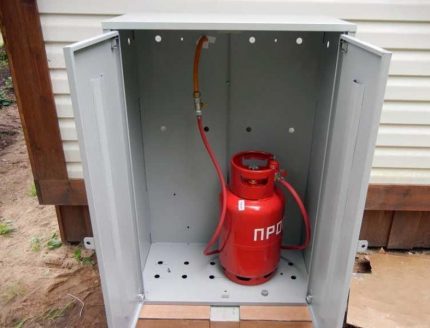
When installed inside the kitchen, the cylinder should:
- at least 1 m from heating appliances and gas ovens, and 0.5 m from the stove itself;
- provide unhindered access to cranes and valves;
- to remain visible and not covered by any combustible finish;
- placed in a place where there is no direct sunlight.
The outlet from the cylinder to the plate is made of steel or copper pipe, as well as rubber, rubber with metal braid or a bellows hose. The tubular product is more reliable, but complicates the relocation of gas equipment. Gas hose more practical, only pick it should be the one that is suitable for gas.
Regardless of the material of execution, the supply must be without connections. Connecting it with threaded fittings or a screed with a clamp on the fitting is permitted only at the points of connection of the shutoff valves and gearbox.
If the cylinder is placed on the street in the closet, then the place for it must be selected at a distance (at a minimum):
- from woodpiles with firewood - 3 m;
- from the windows - 1 m;
- from the entrance to the house - 5 m;
- from ventilation ducts in the walls and basement - 3 m.
Also, at least 1.5 meters cabinets should be moved away from external fans, air conditioners and other electrical appliances on the facade of the building. It is necessary to completely eliminate the risk of sparks near the gas from short circuits in the wiring and any electrical equipment nearby.
Replacing jets in burners
Gas for combustion in the burner enters through special nozzles. For methane, they are connected of one size, and for LPG of another, with a smaller hole.
Blue gas cylinders require jets with a diameter of 0.5–0.75 mm at 30 mbar with a gearbox and 0.43–0.6 with a gearbox pressure of 50 mbar.
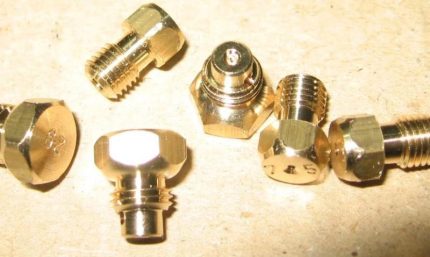
To replace the nozzles, it is necessary to remove the burner body (in some cases the top panel of the stove) and unscrew the hex bolt 7 or 8 mm from the sleeve, with a small hole in the middle. Then the new nozzle is simply screwed into the place of the old one.
Burner Connection Guide
Domestic gas cylinders are commonly used for cooking. But nothing prevents connecting to them as well burner for brazing copper pipes. A similar tool is used for roofing, searing animals during slaughter at home, etc.
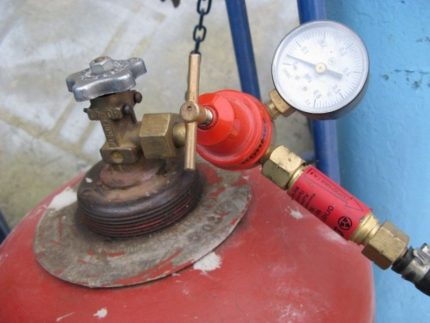
Before connecting the burner to the gas bottle, carefully examine it and the hose to it. Cylinder gas in the tank is under pressure of 15–16 atm.If the burner and outlet are not designed for such parameters, then you will have to connect an adjustable gearbox for propane. Without it, according to the rules of TB it is impossible.
If gas reducer do not connect at all, then the gas will be consumed too much. Of course, you can adjust its flow valve on the cylinder, but it is difficult to talk about any safety of work in this situation.
Conclusions and useful video on the topic
The process of connecting the cylinder to the stove:
Rules for connecting a propane cylinder:
Connection of balloon gas to the hob:
To connect a propane cylinder to a gas stove, competence and special skills are not required. All you need is a wrench and common sense. And do not forget, after connecting, before starting cooking, use soapy water to check for leaks at the joints.
Want to talk about your own experience in connecting gas household appliances to a LPG bottle? Do you have useful information on the topic of the article? Please write comments, ask questions, post photographs on the topic of the article in the block below.

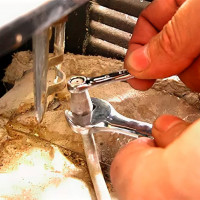 Replacing the nozzles in the Hephaestus gas stove: a detailed guide for replacing nozzles
Replacing the nozzles in the Hephaestus gas stove: a detailed guide for replacing nozzles 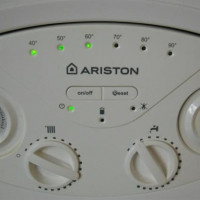 How to connect a gas boiler Ariston: recommendations for installation, connection, configuration and first start-up
How to connect a gas boiler Ariston: recommendations for installation, connection, configuration and first start-up 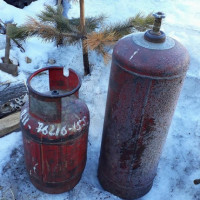 Why is a gas cylinder covered with hoarfrost: causes of freezing of gas in the cylinder and ways to prevent it
Why is a gas cylinder covered with hoarfrost: causes of freezing of gas in the cylinder and ways to prevent it  How to disassemble a gas cylinder: step by step instructions + precautions
How to disassemble a gas cylinder: step by step instructions + precautions 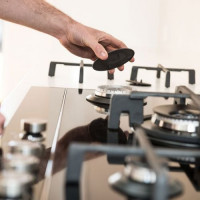 Why the burner does not work on the gas stove: common causes and methods for eliminating them
Why the burner does not work on the gas stove: common causes and methods for eliminating them 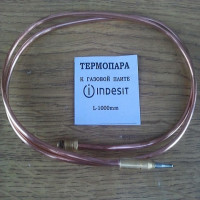 Thermocouple in a gas stove: principle of operation + instruction on replacing the device
Thermocouple in a gas stove: principle of operation + instruction on replacing the device  How much does it cost to connect gas to a private house: the price of organizing gas supply
How much does it cost to connect gas to a private house: the price of organizing gas supply  The best washing machines with dryer: model rating and customer tips
The best washing machines with dryer: model rating and customer tips  What is the color temperature of light and the nuances of choosing the temperature of the lamps to suit your needs
What is the color temperature of light and the nuances of choosing the temperature of the lamps to suit your needs  Replacement of a geyser in an apartment: replacement paperwork + basic norms and requirements
Replacement of a geyser in an apartment: replacement paperwork + basic norms and requirements